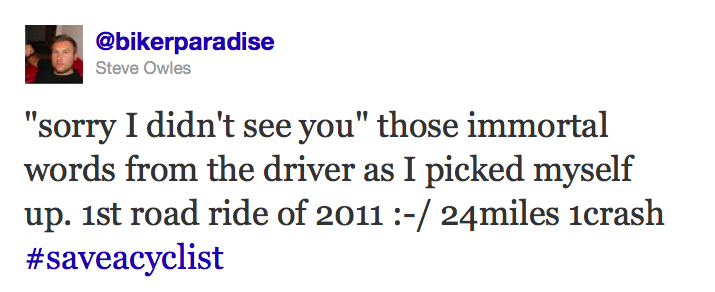Hashtag Tuesday: #saveacyclist
We had a great response to last week’s blog about #twowheeltuesday, where we interviewed @Aus10Nichols of One Tree Hill and Carol of @LACBC about its origins. We’re back with our weekly cycling # feature, and once again Joe anthony has the honors of sharing this week’s story……#saveacyclist.
#saveacyclist
– by Joe Anthony
While we spend most of our time online sharing the irrefutable joys of cycling here, @lovingthebike, and @bikecommutenews….unfortunately the dangers that come along with cycling are all too common.
Transportation in itself is risky, with as many as 50,000 driver fatalities every year in the U.S. alone, but cyclists are particularly vulnerable on the streets. Despite existing laws protecting cyclists, and driver education that anyone with a driver’s license has undergone, many still don’t take care to watch out for cyclists on the roads. The tragedy is that so many of these deaths are preventable.
@bikinginla recently posted a great piece on the vulnerability of cyclists, and just how avoidable car vs. bike collisions really are in a blog posted on @KCRW: I Trust You with My Life. No really.
The truth is that collisions are actually hard to have. If you obey the law, pass and turn safely, and pay attention to the road in front of you — and I do the same — it’s virtually impossible to come in contact with one another.
That’s why, if you’ve noticed, I don’t use the word accident to describe a wreck. Because very few accidents actually are. In order to have one, someone has to do something stupid, careless or illegal to cause it.
And that’s why I have trust in you.
Because I can only control what I do on the road. The rest is your hands.
And I’m counting on you to make sure we both get home safely.
Along with too many others, the new year brought news of the deaths of two promising and accomplished cyclists. Carla Stewart of the HTC-Highroad women’s team was hit and killed by a truck while training in South Africa earlier this year. Lewis Balyckyi , a 2008 national youth circuit race champion who would’ve gone on to compete in the 2012 olympics, was killed just miles from his home after a collision with a van.
These deaths prompted cyclist Kathryne Brown, race administrator for the Tour of Britain and Tour Series, to take to Twitter. She started the hashtag #saveacyclist to help raise awareness and hopefully prevent these completely avoidable and unnecessary deaths.
After some digging, I was able to trace the tag to Kathryne to ask her a few questions about it:
Joe: Did you start #saveacyclist?
Kathryne: yes
Joe: Can you tell us a bit about when, why, and what inspired the tag?
Kathryne: The original tweet was “really sobering news stories today. Please can everyone be careful out there on the roads. #saveacyclist” and I first used it on 19th January 2011. It was just a quick reaction to the news that two more cyclists, Carla Swart and Lewis Balyckyi, had been killed in seperate road traffic accidents. Both were talented young cyclists with great futures ahead of them and both were tragically killed doing what they did best.
Joe: How has the response been? @amyling tells us the tag inspired her to start a Facebook group, a Save the Cyclist campaign. Are you aware of any other action taken beyond twitter that began as a result of the tag?
Kathryne: The response has been amazing. I wasn’t trying to start a campaign, merely convey a sentiment, with the hashtag but it seems that I inspired @amyling to take the idea and run with it. I work within the cycling industry and as a result many of my followers are cyclists or enjoy watching pro cycling races and they were amazingly supportive and only too happy to keep retweeting the #saveacyclist message. I’m also lucky enough to have some high profile cyclists / people involved in cycling following me and they too got involved quickly – within a couple of hours the message had been retweeted by several pro riders. I guess a lot of people were also feeling my sadness and frustration. Other than the facebook group I am not aware of anything else that has happened. We are planning on getting t-shirts and bumper stickers made too. Ideally the hashtag has led to someone thinking and slowing down, passing that little bit wider or perhaps being just a little bit more tolerant of cyclists they meet on the road.
Joe: Any other details you can share? We’d love to know more about you and other ways you may be involved in bike advocacy, especially online.
Kathryne: I’m 35, from Surrey in the UK and I work as the race administrator for The Tour of Britain cycle race – britain’s largest professional cycle race – I am also a member of Charlotteville Cycling Club. My partner is a keen amateur racer who also works within the bike industry. Most weekends I am either supporting him at a race, riding my bike or travelling to watch a pro bike race. Cycling is a major part of my life!
We’re thrilled that Kathryne took the time to spread the word on Twitter. Since that first tweet, hundreds (if not thousands) of other Tweeters caught on and spread the message even further throughout their networks, calling out for awareness and sensitivity toward cyclists and to all who share the roads:
After Kathryne’s initial #saveacyclist tweet began to spread throughout the Twitterverse, Amy O’ Halloran, (mentioned above) picked up on it and took the #saveacyclist campaign even further by starting a Facebook page.
I exchanged a few emails with Amy to ask her about her efforts and how they were progressing:
Amy: Well believe it or not, the campaign is only a couple of days old!! I thought, after the two deaths on wednesday, that it would be a good idea to try and raise road safety awareness. My boyfriend, Rob Partridge, is also a professional rider and is out on the roads and at risk every day! My idea was that, if motorists started to relate to cyclists as human beings rather than second class citizens, then maybe they might think twice before hurling abuse or driving too close!
To do this, I think cyclists should promote road safety OFF their bikes, by wearing T-shirts, bumper stickers etc, with slogans such as “it’s not a race, give cyclists space”. This may then help a driver to relate the “annoying” cyclist back to the man he saw earlier playing with his kids in the park. It’s about bringing compassion back onto the roads, there’s no reason for us all to automatically hate each other! Every life is valuable and not worth risking.
The second element to the campaign is encourgaing cyclists to be amabassadors for their sport and try to give cyclists a good name again. This is to be done by sticking to the highway code and trying not to aggravate drivers unnecessarily. If one cyclist jumps a red light, and annoys a motorist, then they’re gonna take it out on the next cyclist they see! It’s all about mutual respect, sharing the roads. Until the government take more action to discipline careless drivers, we all have to make an effort. If you can change one drivers attitude, and it saves a life one day, then it’s worth it!
The hash tag that Kathryne tweeted was just a passing comment but I thought it would be brilliant to attach it to my campaign ideas. With help from Kathryne, and others, the idea really took off and people started to join the facebook group and tweet the #saveacyclist hashtag. The aim was to get it trending! The t-shirt design is going to have #saveacyclist on the back to keep the twitter momentum going.
The response has been unbelievable, it’s taken off quicker than I expected so I’m having to hurry to sort out my ideas and get things rolling along… Over 1000 “likes” on facebook in 24 hours! The hash tag has been retweeted by teams such as team sky and liquigas, everybody wants to spread the word and everybody thinks the campaign is a great idea. The hash tag is being used on the end of any tweet by any cyclist! It’s really creating enthusiasm between the cycling community to start to make a change in the country. I have decided that a petition is not the way to go at the moment, as the laws are already in place, they are just not enforced!! The way to go is to publicise the campaign and start to put pressure on the government to start enforcing more severe penalties for motorists and re-address road safety issues for vulnerable road users.
As I’m writing this, the #saveacyclist Facebook group has over 1,800 followers.
The #saveacyclist tag is a terrific example of how just taking a moment to share your concerns with others online can have a great impact. What started as a simple tweet resonated around the web reaching potentially thousands of others to take note.
If the sum of all these Tweets and Facebook status updates amounts to inspiring X number of drivers to pay just a little more attention and learn what it means to share the road, mission accomplished.
Every little bit helps.
 Joe Anthony has been involved in online community building, web strategy and consulting for the better part of the last decade. A cyclist living car-free in Los Angeles, he advocates bikes and tech online @bikecommutenews.
Joe Anthony has been involved in online community building, web strategy and consulting for the better part of the last decade. A cyclist living car-free in Los Angeles, he advocates bikes and tech online @bikecommutenews.




From my Blog of January the 20th 2011 http://www.massivemtber.co.uk/?paged=2
“it’s my belief that the cyclist is at the end of the day responsible for himself. I know in law, every body has a duty of care to ensure they don’t put others at risk, but we do not live in that kind of world despite what the law says. I always cycle as though every body is out to kill me, in effect I do everyone’s thinking for them, trying (and mostly succeeding), to anticipate every possible outcome at every traffic scenario. Obviously there’s the unseen, unheard car that can bite you, but on the whole, pedalling in traffic is as dangerous or as safe as the persons wits on the saddle.
I’m never scared when I’m pedalling on the road. I’m not a victim and I can bloody well hold my own with any traffic scenario!”
Probably not what cyclists want to hear, but until I have faith in other road users (unlikely that will ever happen) then I’ll rely on myself.
Be careful out there people, but don’t be afraid and be assertive when you pedal.
Cheers
Clive
“That’s why, if you’ve noticed, I don’t use the word accident to describe a wreck. Because very few accidents actually are. In order to have one, someone has to do something stupid, careless or illegal to cause it.”
Can’t emphasize that point more, except to say that mishaps very rarely have a single cause. They are more likely to be caused by a chain of actions and events.
Let us also not forget that in most credible mishap studies (at least in the U.S.) show that in car-bike collisions, cyclists have some in fault in about half of the mishaps.
Great post Darryl.